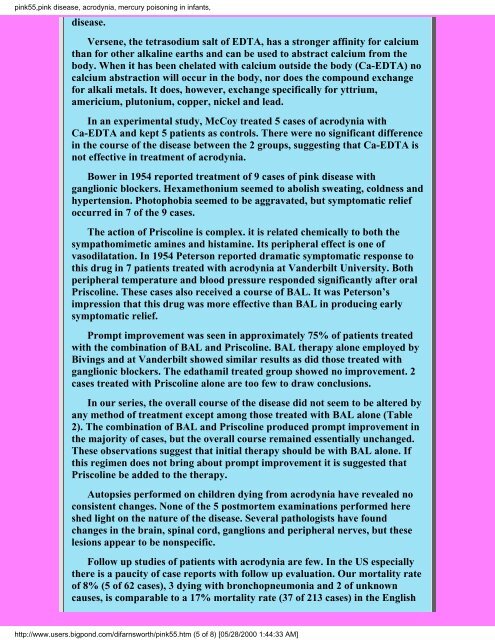Create successful ePaper yourself
Turn your PDF publications into a flip-book with our unique Google optimized e-Paper software.
pink55,pink disease, acrodynia, mercury poisoning in infants,disease.Versene, the tetrasodium salt of EDTA, has a stronger affinity for calciumthan for other alkaline earths and can be used to abstract calcium from thebody. When it has been chelated with calcium outside the body (Ca-EDTA) nocalcium abstraction will occur in the body, nor does the compound exchangefor alkali metals. It does, however, exchange specifically for yttrium,americium, plutonium, copper, nickel and lead.In an experimental study, McCoy treated 5 cases of acrodynia withCa-EDTA and kept 5 patients as controls. There were no significant differencein the course of the disease between the 2 groups, suggesting that Ca-EDTA isnot effective in treatment of acrodynia.Bower in 1954 reported treatment of 9 cases of pink disease withganglionic blockers. Hexamethonium seemed to abolish sweating, coldness andhypertension. Photophobia seemed to be aggravated, but symptomatic reliefoccurred in 7 of the 9 cases.The action of Priscoline is complex. it is related chemically to both thesympathomimetic amines and histamine. Its peripheral effect is one ofvasodilatation. In 1954 Peterson reported dramatic symptomatic response tothis drug in 7 patients treated with acrodynia at Vanderbilt University. Bothperipheral temperature and blood pressure responded significantly after oralPriscoline. These cases also received a course of BAL. It was Peterson’simpression that this drug was more effective than BAL in producing earlysymptomatic relief.Prompt improvement was seen in approximately 75% of patients treatedwith the combination of BAL and Priscoline. BAL therapy alone employed byBivings and at Vanderbilt showed similar results as did those treated withganglionic blockers. The edathamil treated group showed no improvement. 2cases treated with Priscoline alone are too few to draw conclusions.In our series, the overall course of the disease did not seem to be altered byany method of treatment except among those treated with BAL alone (Table2). The combination of BAL and Priscoline produced prompt improvement inthe majority of cases, but the overall course remained essentially unchanged.These observations suggest that initial therapy should be with BAL alone. Ifthis regimen does not bring about prompt improvement it is suggested thatPriscoline be added to the therapy.Autopsies performed on children dying from acrodynia have revealed noconsistent changes. None of the 5 postmortem examinations performed hereshed light on the nature of the disease. Several pathologists have foundchanges in the brain, spinal cord, ganglions and peripheral nerves, but theselesions appear to be nonspecific.Follow up studies of patients with acrodynia are few. In the US especiallythere is a paucity of case reports with follow up evaluation. Our mortality rateof 8% (5 of 62 cases), 3 dying with bronchopneumonia and 2 of unknowncauses, is comparable to a 17% mortality rate (37 of 213 cases) in the Englishhttp://www.users.bigpond.com/difarnsworth/pink55.htm (5 of 8) [05/28/2000 1:44:33 AM]


